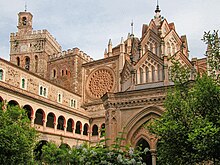Monastery of Saint Mary of Guadalupe
Roman Catholic monastery in Guadalupe, Extremadura, Spain From Wikipedia, the free encyclopedia
Roman Catholic monastery in Guadalupe, Extremadura, Spain From Wikipedia, the free encyclopedia
The Royal Monastery of Saint Mary of Guadalupe (Spanish: Real Monasterio de Santa María de Guadalupe) is a Roman Catholic monastic establishment built during the 14th century located in Guadalupe, in Extremadura, Spain. It is located at the foot of the eastern side of the Sierra de las Villuercas and was one of the most important and fine monasteries in the country for more than four centuries. UNESCO declared it a World Heritage Site in 1993.
| Royal Monastery of Saint Mary of Guadalupe | |
|---|---|
Real Monasterio de Santa María de Guadalupe | |
 | |
| Religion | |
| Affiliation | Catholic |
| Ecclesiastical or organizational status | Monastery |
| Location | |
| Location | Guadalupe (Cáceres), Spain |
| Geographic coordinates | 39°27′10″N 5°19′39″W |
| Criteria | Cultural: (iv), (vi) |
| Designated | 1993 (17th session) |
| Reference no. | 665 |
| Region | Europe and North America |
| Area | 1.1 ha (2.7 acres) |
| Buffer zone | 43.65 ha (107.9 acres) |
| Type | Non-movable |
| Criteria | Monument |
| Designated | 1 March 1879 |
| Reference no. | RI-51-0000024 |
The monastery had its origins in the late 13th century, when a shepherd from Cáceres, named Gil Cordero, discovered on the bank of the Guadalupe River a statue of the Blessed Virgin,[1] which had been apparently hidden by local inhabitants from Moorish invaders in 714. On the site of his discovery a chapel was built, dedicated under the title of Our Lady of Guadalupe.[2]
King Alfonso XI, who visited the chapel more than once, invoked Santa Maria de Guadalupe in the Battle of Rio Salado. After gaining the victory, he ascribed it to the Madonna's intercession, declared the church at Guadalupe a royal sanctuary and undertook an extensive rebuilding program.
In 1389, the Hieronymite monks took over the monastery and made it their principal house. Construction works continued under the auspices of the order's first prior, and in 1474 Henry IV of Castile was entombed in Guadalupe, next to his mother.
King Ferdinand II of Aragon issued the Sentencia Arbitral de Guadalupe at the monastery on 21 April 1486, thus effectively ending the onerous evil customs allowing medieval nobles in Catalonia to maltreat the remensa peasants and tie them to their lands.
The monastery has rich associations with the New World, including the Guadeloupe island in the Caribbean. It was here in Extremadura where Christopher Columbus made his first pilgrimage after discovering America in 1492 and where he first thanked heaven for his discovery.
Even after the monks from Guadalupe founded the famous monastery of Escorial, which was much closer to the royal capital, Madrid, Santa Maria de Guadalupe retained the royal patronage. It remained the most important cloister in Spain until the Confiscation of monasteries in 1835. In the 20th century, the monastery was revived by the Franciscan Order and Pope Pius XII declared the shrine a "Minor Papal Basilica" in 1955.


The monastery, whose architecture evolved throughout many centuries, is still dominated by the templo mayor, or the main church, built by Alfonso XI and his immediate successors in the 14th and 15th centuries. The square chapel of Santa Catalina is also of the 15th century; it is known for a cluster of ornate 17th-century tombs. The 16th-century reliquaries chapel connects Santa Catalina with the baroque sacristy (1638–1647), lavishly decorated and boasting a series of paintings by Zurbarán.
Behind the basilica is Camarin de la Virgen, an octagonal baroque structure (1687–1696) with the stuccoed Chamber of the Virgin and nine paintings by Luca Giordano. The jewel of this profusely ornamented hall is a throne containing the statue of the Madonna which gave the monastery its name.
Other notable structures include the Mudéjar cloister (1389–1405), with the magnificent Plateresque portal; the late Gothic cloister from 1531–1533, and the new church, commissioned by one of Columbus's descendants in 1730. Regrettably, the palace of Isabella I of Castile (1487–1491) was pulled down in 1856.
The sanctuary is divided into:
Seamless Wikipedia browsing. On steroids.
Every time you click a link to Wikipedia, Wiktionary or Wikiquote in your browser's search results, it will show the modern Wikiwand interface.
Wikiwand extension is a five stars, simple, with minimum permission required to keep your browsing private, safe and transparent.